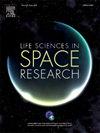Mouse hindlimb unloading, as a model of simulated microgravity, leads to dysregulated iron homeostasis in liver and skeletal muscle cells
IF 2.8
3区 生物学
Q2 ASTRONOMY & ASTROPHYSICS
引用次数: 0
Abstract
Microgravity exposure can impact various physiological systems, yet its specific effects on liver cells remain inadequately studied. To address this gap, we used a hindlimb unloading (HU) mouse model to simulate microgravity conditions and investigate alterations in iron metabolism within liver and skeletal muscle cells. 16-week-old male C57BL/6j mice were divided into three groups: (i) ground-based control (GC), (ii) hindlimb unloading treated with vehicle (HU-v), and (iii) hindlimb unloading treated with deferoxamine (DFO). After three weeks, mice were euthanized, and samples of gastrocnemius muscle, liver, and serum were collected for analysis. The HU-v group exhibited significant muscle and liver cell atrophy compared to the GC group, along with disrupted iron metabolism, as indicated by altered expression of key iron regulatory proteins, including FTH1, FPN, TFR1, IRP-1, HMOX-1, and Hepcidin. In contrast, the DFO group demonstrated restored iron homeostasis, with protein expression patterns resembling those of the GC group. Serum analysis revealed elevated levels of serum iron, ferritin, and transferrin in the DFO group compared to both HU-v and GC groups, albeit with minimal changes in total iron-binding capacity. These findings suggest that simulated microgravity induces iron overload and cellular atrophy in liver and skeletal muscle cells, highlighting the potential therapeutic benefits of iron chelation in such conditions.

小鼠后肢卸载,作为模拟微重力的模型,导致肝脏和骨骼肌细胞铁稳态失调
微重力暴露可以影响各种生理系统,但其对肝细胞的具体影响仍未充分研究。为了解决这一差距,我们使用后肢卸载(HU)小鼠模型来模拟微重力条件,并研究肝脏和骨骼肌细胞内铁代谢的变化。将16周龄雄性C57BL/6j小鼠分为地面对照组(GC)、载药后肢卸药组(HU-v)和去铁胺后肢卸药组(DFO)。三周后,对小鼠实施安乐死,并收集腓肠肌、肝脏和血清样本进行分析。与GC组相比,HU-v组表现出明显的肌肉和肝细胞萎缩,并伴有铁代谢中断,这表明关键铁调节蛋白的表达改变,包括FTH1、FPN、TFR1、IRP-1、HMOX-1和Hepcidin。相反,DFO组表现出恢复的铁稳态,蛋白质表达模式与GC组相似。血清分析显示,与HU-v和GC组相比,DFO组的血清铁、铁蛋白和转铁蛋白水平升高,尽管总铁结合能力变化很小。这些研究结果表明,模拟微重力诱导肝脏和骨骼肌细胞铁超载和细胞萎缩,强调了铁螯合在这种情况下的潜在治疗益处。
本文章由计算机程序翻译,如有差异,请以英文原文为准。
求助全文
约1分钟内获得全文
求助全文
来源期刊

Life Sciences in Space Research
Agricultural and Biological Sciences-Agricultural and Biological Sciences (miscellaneous)
CiteScore
5.30
自引率
8.00%
发文量
69
期刊介绍:
Life Sciences in Space Research publishes high quality original research and review articles in areas previously covered by the Life Sciences section of COSPAR''s other society journal Advances in Space Research.
Life Sciences in Space Research features an editorial team of top scientists in the space radiation field and guarantees a fast turnaround time from submission to editorial decision.
 求助内容:
求助内容: 应助结果提醒方式:
应助结果提醒方式:


